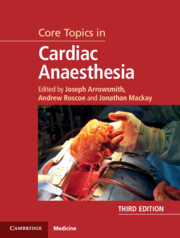Book contents
- Core Topics in Cardiac Anaesthesia
- Core Topics in Cardiac Anaesthesia
- Copyright page
- Dedication
- Contents
- Contributors
- Reviews of the First Edition
- Preface to the Third Edition
- Preface to the First Edition
- Foreword to the First Edition
- Abbreviations
- Section 1 Routine Cardiac Surgery
- Chapter 1 Basic Principles of Cardiac Surgery
- Chapter 2 Symptoms and Signs of Cardiac Disease
- Chapter 3 Diagnostic Techniques
- Chapter 4 Conduct of Anaesthesia
- Chapter 5 Principles of Cardiopulmonary Bypass
- Chapter 6 Weaning from Cardiopulmonary Bypass
- Chapter 7 Routine Early Postoperative Care
- Chapter 8 Common Postoperative Complications
- Section 2 Anaesthesia for Specific Procedures
- Section 3 Cardiac Catheter Laboratory Procedures
- Section 4 Paediatric Cardiac Surgery
- Section 5 Cardiopulmonary Bypass
- Section 6 Advanced Monitoring
- Section 7 Transoesophageal Echocardiography
- Section 8 Miscellaneous Topics
- Index
- References
Chapter 5 - Principles of Cardiopulmonary Bypass
from Section 1 - Routine Cardiac Surgery
Published online by Cambridge University Press: 12 May 2020
- Core Topics in Cardiac Anaesthesia
- Core Topics in Cardiac Anaesthesia
- Copyright page
- Dedication
- Contents
- Contributors
- Reviews of the First Edition
- Preface to the Third Edition
- Preface to the First Edition
- Foreword to the First Edition
- Abbreviations
- Section 1 Routine Cardiac Surgery
- Chapter 1 Basic Principles of Cardiac Surgery
- Chapter 2 Symptoms and Signs of Cardiac Disease
- Chapter 3 Diagnostic Techniques
- Chapter 4 Conduct of Anaesthesia
- Chapter 5 Principles of Cardiopulmonary Bypass
- Chapter 6 Weaning from Cardiopulmonary Bypass
- Chapter 7 Routine Early Postoperative Care
- Chapter 8 Common Postoperative Complications
- Section 2 Anaesthesia for Specific Procedures
- Section 3 Cardiac Catheter Laboratory Procedures
- Section 4 Paediatric Cardiac Surgery
- Section 5 Cardiopulmonary Bypass
- Section 6 Advanced Monitoring
- Section 7 Transoesophageal Echocardiography
- Section 8 Miscellaneous Topics
- Index
- References
Summary
The ideal operating conditions to enable cardiac surgery are a bloodless and motionless field. This requires both cardiac arrest and the drainage of blood from the heart. In order to provide these conditions a separate means of maintaining nutrient supply to the rest of the body is needed. In addition, the heart must be prevented from becoming sufficiently ischaemic as to infarct previously viable muscle.
- Type
- Chapter
- Information
- Core Topics in Cardiac Anaesthesia , pp. 30 - 44Publisher: Cambridge University PressPrint publication year: 2020



